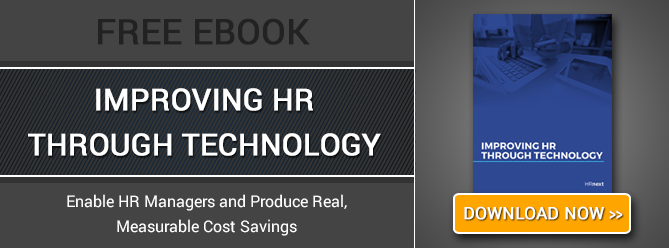Becoming an HR-data-driven organization – HRIS Software
For generations, invaluable HR and other organizational data has been filed away in cabinets or disconnected databases. That valuable data was often left to collect dust, both literally and figuratively speaking. The older the data became, the less actionable and valuable it was. Back then, organizations were not making decisions or driving their bottom line through their data… not as they are today. Perhaps it wasn’t feasible or economical, but today, that has all changed.

HRIS Software & Human Capital Management Technology
Today, for the HR profession, this challenge of data inaccessibility has drastically changed through the emergence of integrated HRIS software, small business HR software, and integrated Human Capital Management (HCM) systems, which offers a suite of critical HR solutions through a single login portal for HR staff, including time and labor, payroll, benefits, recruiting, employee data management and more. Why should you care about the emergence of HCM technology? Very simply put, if employers adopt such tools, they will immediately begin to save countless hours of administration, reduce workforce expenses, increase staff productivity, and reduce the risk of workplace non-compliance. What’s more, an HCM solution is a tremendous, yet very economical investment for employers to implement. In today’s complex environment of data and compliance, all employers should have such a solution, whether small, medium or large.Data Access – A Strength or a Weakness?
Are you still juggling HR data in spreadsheets? Previously, access to HR data was a burden requiring hours of manual spreadsheet analysis and pivot table headaches. Organizing data was a challenge, but retrieving that data was an even greater difficulty. Few HR professionals had the luxury or time to pursue the necessary data on a regular basis in order to drive strategic business decisions. As a result, data that we consider essential today simply wasn’t available to make those decisions. Many companies today are separating themselves from the competition in how they use meaningful data to significantly reduce administrative costs and hours, increase staff productivity, and reduce workforce costs. Meanwhile, other organizations continue to inadvertently ignore some of their most valuable data under the assumption that it’s either not feasible, practical, or necessary to bring that data into regular use. With the rapid advancements and accessibility of technology over the past 10-plus years, most companies have become more data driven. Some, however, are capitalizing more than others. Data that was once buried in archaic, disconnected systems is now available on-demand through customizable dashboards and smart report writers. Managers have instant access in great detail about their cost of labor, staff output and much more with a few clicks. In contrast, many companies have not yet even discovered Human Capital Management technology.Human Capital Management Modules
Transitioning to an HR-data-driven organization is more a matter of choice than anything. The technology is readily available to companies of any size, both in terms of pricing and implementation. And with the ease of today’s cloud-based software, getting up and running is no longer a mountain to climb for HR… with monumental technology and data migrations to worry about. Further, the cost of the technology has become highly affordable for any size of organization. Below is a brief list of some of the integrated modules available in a HRIS software and/or Human Capital Management (HCM) solution:- Payroll and tax processing
- Time and attendance
- Employee scheduling
- Absence and leave management
- Benefit tracking
- Applicant tracking and new hire onboarding
- Reporting and compliance
- Employee HR data management (HRIS)





Leave a Reply
Want to join the discussion?Feel free to contribute!